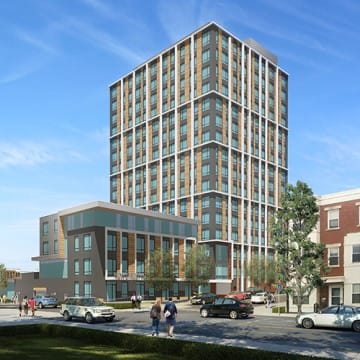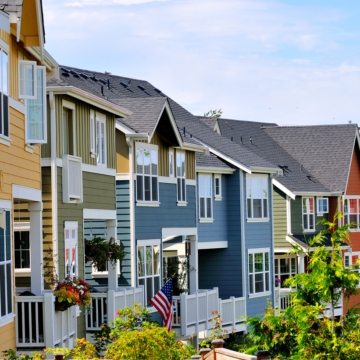Avimor
Avimor is a 35-square-mile development in the foothills of Boise, Idaho, where resilience strategies have helped attract homeowners and commercial tenants while limiting damages from two wildfire events.
Wildfire resilience is top of mind in Boise, which had 32 wildfires within two miles of the city’s border between 2000 and 2015. Also, “the growth trend in this area is very fast. Boise is the major metro area, and it’s surrounded by several smaller cities that meld into one area. We’re running out of room quickly,” says Charles Baun, wildfire expert and owner of ECS Inc., which consulted on the project.
In addition to expanding wildland-urban interface (WUI) development, “we estimate we’re about 20,000 homes short of meeting the need in the valley, and Ada County is expected to grow by a few hundred thousand people by 2040,” says Dan Richter, managing partner for Avimor Development.
Avimor is the second community in Idaho to be a nationally registered Firewise USA community, and one of the first in the nation to earn the certification as a new large development. Development started in 2004, was approved in 2006, and the first residential unit was completed in 2008. Avimor has 600 homes and several commercial buildings completed or under construction as of July 2020. With 300 homes constructed each year, it will gradually expand to 10,000 homes and become the largest development in the county over the next 60 years.
WILDFIRE RESILIENCE STRATEGIES
The Avimor leadership team hired a consultant to update the original site plan to make the development more wildfire resilient and the team worked closely with the local fire districts (Eagle and Boise) on the overall approach. The consultant’s first step was to map and classify vegetation across Avimor’s 35,000 acres to model fire risk, while also identifying and mitigating impacts to habitat and wildlife in the region.
Avimor has centralized development within large expanses of open space and it has recreational trail and road networks that act as fuel breaks and buffers. These transportation corridors also provide defined, easily accessible points for wildland firefighters and their equipment to access the surrounding foothills and open space. As part of the planning process, the development team identified and
mapped all the access points for firefighters, which makes response easier, faster, and potentially safer. The team also developed several
on-site landscaping and fishing ponds that dual-function as dipping stations for firefighting helicopters.
“Proactive management of fuels in the adjacent open spaces coupled with Firewise landscaping guidelines and structural requirements save money, protect homes, and save lives.” – Dan Richter, Managing Partner, Avimor
The development team also created a wildland fire plan, a recreation plan, a noxious and invasive weeds plan, and a wildlife plan—most of which are above planning requirements. Avimor was the first development in Ada County to write its own fire plan. “NFPA 1144 standards [Standard for Reducing Structure Ignition Hazards from Wildland Fire] are guided toward single units that are surrounded 360 degrees by woodlands or other WUI areas. It’s not developed around planned communities or subdivisions, so we developed a new standard that incorporated the infrastructure found in these types of higher-density developments,” says Baun.
Avimor’s buildings have cementitious siding and class A roofs. Residential units located on the development’s periphery are required to have their landscape plan reviewed and approved by a certified Firewise USA specialist. Once units and landscapes are installed, the residents participate in an on-site review with the specialist to go over the Firewise aspects of the home and landscape plan, with a follow-up audit every five years.
In addition, Avimor charges tenants a fire impact fee. Homeowners contribute $10 each month to the Avimor Stewardship Organization to fund significant wildland improvement projects.
BUSINESS OUTCOME
Avimor reports that wildfire resilience was a “negligible cost increase” on new structures and a worthwhile upfront investment, especially because retrofitting homes and buildings to Firewise standards at a later point would have been significantly more expensive. The team saved money by not installing internal sprinkler systems—given the area’s topography, internal sprinkler systems might have been ineffective in the event of a fire because of the lack of water pressure. “Our prices are on par with homes being built in the valley where they don’t do all this wildfire resilience or have the open space. People feel like they’re getting a bargain here,” says Richter.
Across the development, the fire-adapted landscaping uses 60 to 80 percent less water than conventional designs in the region, and the site layout of clustered and buffered density contributes to cost efficiencies and resilience. Areas adjacent to the development are also mowed regularly to create strategically placed fuel breaks to slow external wildfires. “The slopes come back looking so much better. There’s a real difference between the slopes that have never been mowed and those that we treat,” says Richter. Tenants also appreciate the careful land stewardship and Firewise USA programs and turn out in significant numbers for volunteer trail maintenance and native vegetation planting days.
Avimor has weathered two recent fires—one in 2016 and one in 2018—that were started by vehicles on nearby roads. In both cases, the fire was directly adjacent to the property, but no people or structures were harmed.


